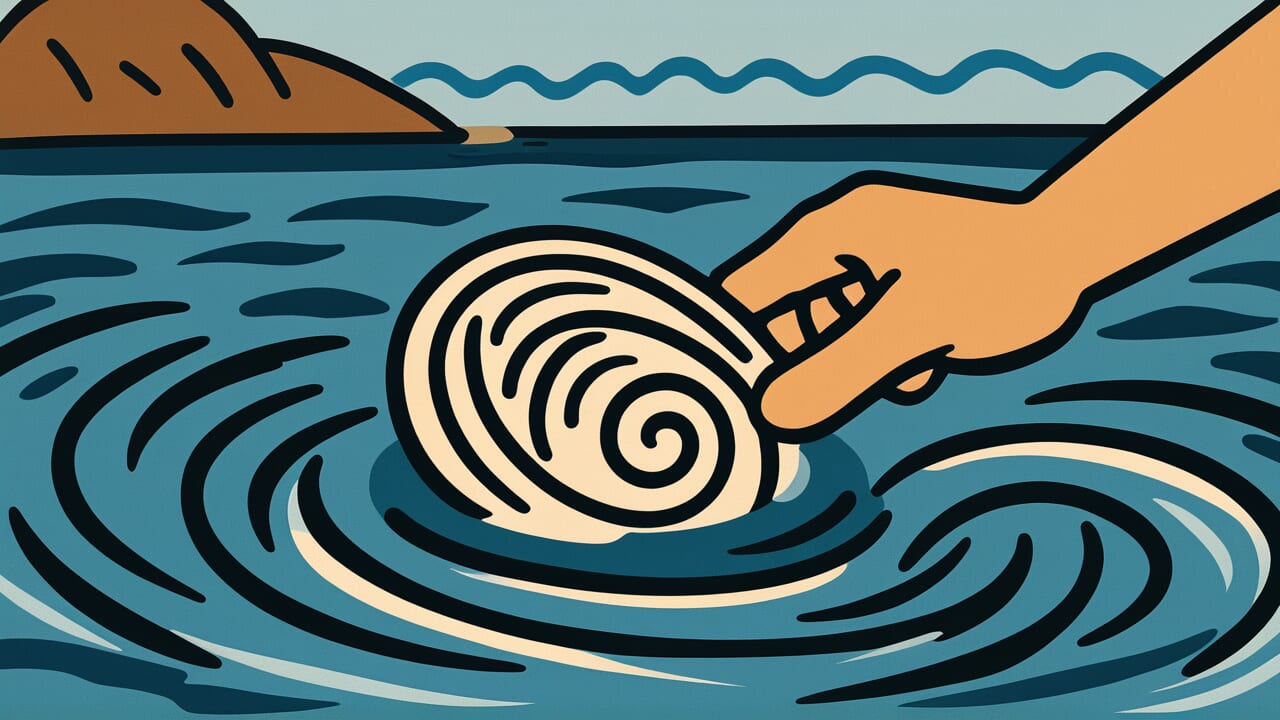How to Read “The side of rapids is a whirlpool”
se no waki wa uzu
Meaning of “The side of rapids is a whirlpool”
“The side of rapids is a whirlpool” is a proverb that warns us about hidden dangers in situations that appear calm and safe on the surface. The edges of shallow rapids may look quiet, but whirlpools actually swirl there dangerously.
This teaches us not to judge by appearances alone.
This proverb reminds us to stay alert and careful, especially in peaceful situations where we feel completely safe. It’s used to encourage caution when things are going smoothly, or to warn people who feel too comfortable in seemingly peaceful circumstances.
Even today, risks often hide beneath the surface of business deals, relationships, or projects that seem problem-free. This proverb helps us realize that “now is exactly when we need to pay attention.”
Origin and Etymology
No clear written records explain the origin of this proverb. However, we can make interesting observations from how the phrase is constructed.
“Se” refers to shallow parts of a river where water flows fast. Japanese people have lived alongside rivers since ancient times and observed their nature closely.
When crossing rivers, rapids seemed easier to cross because they were shallow. But they actually required careful attention.
“Waki” means edge or side. The center of the current shows visible water movement that’s easy to understand. But at the edges, complex currents form.
The relationship between rocks and riverbanks creates situations where the surface looks calm while whirlpools spin below.
In times when rivers were part of daily life, people regularly witnessed these natural phenomena. They learned this lesson from experiences of losing their footing in seemingly calm spots or encountering unexpected dangers.
Wisdom gained from observing rivers eventually became a universal lesson applicable to many aspects of human society. This proverb contains the vigilance our ancestors felt toward invisible dangers in nature.
Usage Examples
- The new business is going too smoothly and I’m worried. The side of rapids is a whirlpool, so let’s proceed carefully right now.
- I thought it was a peaceful workplace, but the side of rapids is a whirlpool—there were actually factional conflicts happening.
Universal Wisdom
Behind the enduring wisdom of “The side of rapids is a whirlpool” lies a deep insight into a fundamental human weakness. That weakness is our overwhelming dependence on “what we can see.”
The human brain prioritizes processing visible information. When we see a calm water surface, we judge it safe. When we see a quiet scene, we believe it’s peaceful.
This ability developed for survival, but it’s also a major pitfall.
The truth this proverb reveals is that danger doesn’t always appear in visible forms. Rather, the dangers we should truly watch for hide in silence, behind tranquility, and in the shadows of smooth progress.
When surface peace continues, people lower their guard, lose their powers of observation, and stop thinking.
Our ancestors understood this human weakness. That’s why they left us this paradoxical teaching: “danger exists precisely in places that look calm.”
This isn’t just about being cautious. It’s a warning about the human habit of judging only by surfaces.
We’re most vulnerable when we feel safe. This universal truth will remain valid wisdom forever, as long as human nature stays unchanged.
When AI Hears This
Whirlpool formation in fast-flowing rivers is exactly the phenomenon fluid dynamics calls “localized energy concentration destroying structure.” When water hits obstacles like rocks or the riverbed, flow velocity suddenly increases at those points.
Then a value called the Reynolds number, which describes water flow, exceeds a critical threshold. The orderly laminar flow that existed until then instantly transforms into turbulent flow.
What’s interesting are the conditions where this phase transition occurs. When flow velocity doubles, the force generating turbulence increases more than fourfold.
In other words, small velocity differences trigger dramatic changes. When energy gets compressed into the limited space of rapids, interactions between water molecules become complex, creating unpredictable vortex motion.
This follows the same principle as the strongest winds occurring around a typhoon’s eye.
Even more noteworthy is how the whirlpool itself functions as an energy-consuming device. The kinetic energy in river flow converts to thermal energy by creating whirlpools, which eventually dissipates.
Nature automatically creates whirlpools as “relief valves” where energy concentrates too much. The whirlpool at the side of rapids isn’t mere turbulence—it’s an ingenious mechanism for the system to maintain stability.
Lessons for Today
What this proverb teaches you today is the importance of “the courage to stop and observe when things are going well.”
In our busy daily lives, we tend to stop thinking deeply precisely when things are progressing smoothly. We assume everything’s fine because no problems have surfaced, and we keep rushing forward.
But what we really need is the perspective to step back and survey the whole picture during peaceful times.
Specifically, this means taking time to hear your team’s honest thoughts when a project is going smoothly. It means maintaining the sensitivity to notice small changes in others when relationships are good.
It means reviewing your lifestyle habits when you’re healthy.
This isn’t about becoming paranoid. Rather, it’s loving attention that protects what matters. The attitude of trying to see the truth beneath the surface, not just what’s visible.
This becomes the power to protect your own happiness and that of those around you.
Be grateful for peaceful days while also looking at what lies beneath them. By maintaining this sense of balance, you can gain more genuine peace of mind.



Comments